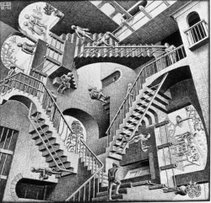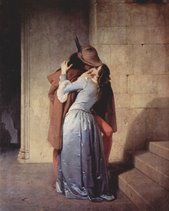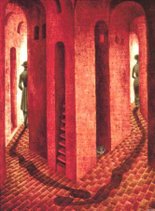Saturday, August 30, 2008
English-Asylum for the verbally insane
English-Asylum for the verbally insane
We'll begin with a box and the plural is boxes.
But the plural of ox becomes oxen, not oxes.
One fowl is a goose, but two are called geese,
yet the plural of moose should never be meese.
You may find a lone mouse or a nest full of mice,
yet the plural of house is houses, not hice.
If the plural of man is always called men,
why shouldn't the plural of pan be called pen?
If I speak of my foot and show you my feet,
and I give you a boot, would a pair be called beet?
If one is a tooth and a whole set are teeth,
why shouldn't the plurall of booth be called beeth?
Then one may be that, and three would be those,
yet hat in the plural would never bee hose,
and the plural of cat is cats, not cose.
We speak of a brother and also of brethren.
But though we say mother, we never say methren.
Then the masculine pronouns are he, his and him,
but imagine the feminine: she, shis and shim!
Let's face it. English is a crazy language.
There is no egg in eggplant nor ham in hamburger;
neither apple nor pine in pineaplle.
English muffins weren't invented in England.
We take English for granted, but if we explore its paradoxes,
we find that quicsand can work slowly, boxing rings are square,
and a guinea pig is neither from Guinea nor is a pig.
And why is that writers write but fingers don't fing,
grocers don't groce and hammers don't ham?
If teacher taught, why didn't preachers praught?
If a vegetarian eats vegetables, what does a humanitarian eat?
Sometimes I think all the folks who grew up speaking English
should be committed to an asylum for the verbally insane.
In what other language do peoplerecite at a play and play at a recital?
We ship by truck and send cargo by ship.
We have noses that run and feet that smell.
We park in the driveway and drive in the parkway.
And how can a slim chance and a fat chance be the same,
while a wise man and a wise guy are opposites?
You have to marvel at the unique lunacy of a language in which
your house can burn up as it burns down,
in which you fill in a form by filling it out,
and in which an alarm goes off by going on.
And, in closing, if Father Pop, how come Mother's not Mop?
Thursday, August 28, 2008
Engels leren
Yeah. It is kind of important to understand a little what the music you like is about!
Wednesday, August 27, 2008
Indefinite plural form of Swedish nouns
Swedish, Norwegian and Danish behave pretty much the same when it comes to grammar. The form of their nouns (definite and indenite in singular and plural) is something that can be difficult for learners.
There are five main ways of forming the plural of nouns in Swedish:
- en blomma (a flower) → två blummor. The majority of nouns in this declension are en-nouns ending in -a. They drop the -a before the plural ending. A few nouns of this group do not end in -a (en rose, en våg, en åder).
- en arm (an arm) → två armar. All nouns belonging to this declension are en-nouns (with the exception of ett finger → två fingrar). All en-nouns ending in -dom and -ing belong to this group.
- en kostym (a suit) → två kostymer. Both en-nouns and ett-nouns are found in this declension. note that many nouns in this group modify their stem-vowel in the plural. Latin words ending in -eum and -ium belong to this group.
- ett äpple (an apple) → två äpplen. The majority of nouns in this declension are ett-nouns ending in a vowel, usually -e.
- ett glas (a glass) → två glas. They have no ending. To shis declension belong ett-nouns ending in a consonant and en-nouns ending in -are, -ande and -ende. note that some common nouns also modify their stem-vowel (en bro(de)r → två bröder, en man → två män).
According to the book Basic Swedish word list, by Martin Samuel Allwood, 12 % of the 1000 most used Swedish words belong to the first declension; 37 %, to the second; 21 %, to the third; 4 %, to the fourth; and 26 %, to the fifth.
All this would be pretty cool if I had already told the whole story.
Nouns ending in unstressed -e, -el, -en and -er drop the -e before the plural endings -or, -ar and -er:
en toffel (a slipper) → två tofflor, en poijke (a boy) → två pijkar, en dotter → två döttar (note here also the change in the stem-vowel), en regel (a rule) → två regler.
Some nouns form their plural with the ending -r only: en händelse (an event) → två händelser, en ko (a cow) → två kor.
As you can see, some nouns change the stem-vowel and some other, beside that change, also double the final consonant.
Yes, it is like Norwegian... but this is not helping!
Tuesday, August 26, 2008
More Danish language
There is a second part to it! These guys are really funny. Here it is:
Monday, August 25, 2008
Schemata
Every time we face a situation in language learning, we relay on our schemata and not only on the linguistic information we are facing. These schemata are unconscious mental structures that represent an individual's generic knowledge about the world. It is through schemata that old knowledge influences new information.
Relationships among different levels of abstraction are conceived to be like webs (rather than hierarchical); thus each one is interconnected with many others (as in the image above).
In 1977, Richard C. Anderson brought this concept into the education field. But the term was not entirely new as Piaget had already used it.
According to Anderson, some characteristics of schemata are:
- Schemata are always organized meaningfully, can be added to, and, as an individual gains experience, develop to include more variables and more specificity.
- Each schema is embedded in other schemata and itself contains subschema.
- Schemata change moment by moment as information is received.
- They may also be reorganized when incoming data reveals a need to restructure the concept.
- The mental representations used during perception and comprehension, and which evolve as a result of these processes, combine to form a whole which is greater than the sum of its parts.












